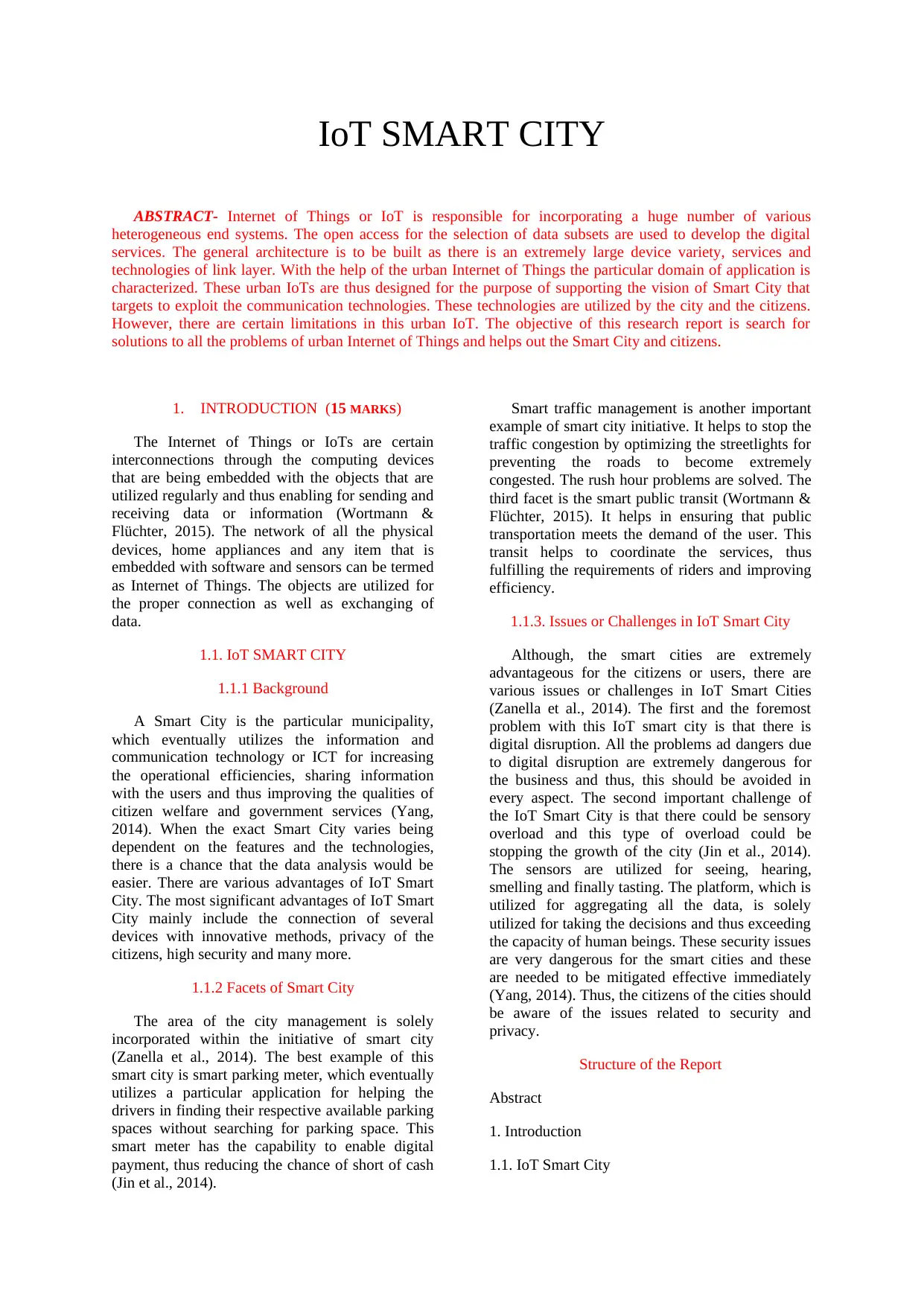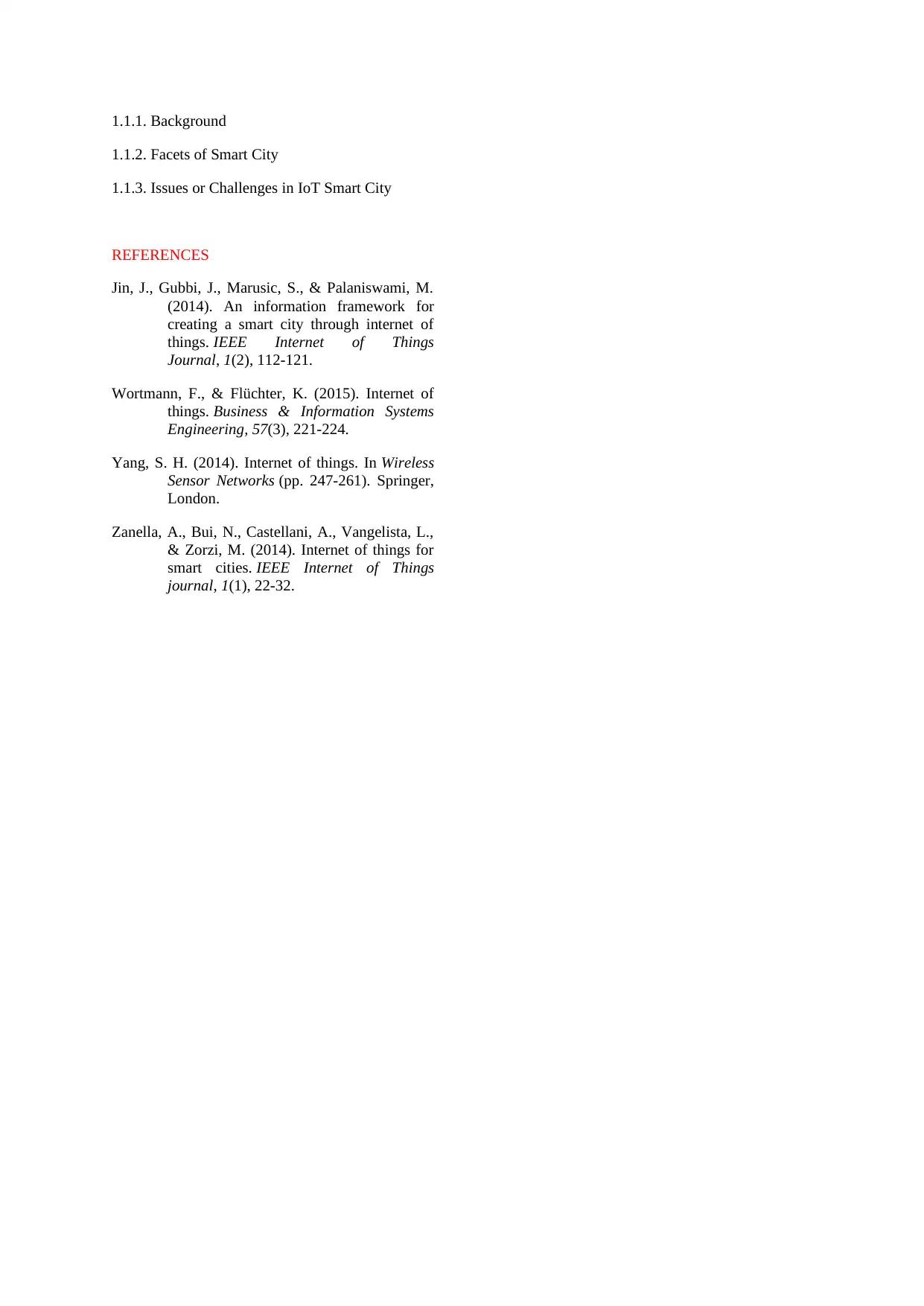IoT Smart City: Analyzing Challenges, Solutions, and Future Trends
VerifiedAdded on 2023/06/13
|2
|926
|335
Report
AI Summary
This report provides an overview of the challenges and potential solutions in developing IoT Smart Cities. It begins with an introduction to the Internet of Things (IoT) and its application in creating Smart Cities, highlighting the various facets of a Smart City, such as smart parking, traffic management, and public transit. The report then delves into the issues and challenges associated with IoT Smart Cities, including digital disruption and sensory overload. It emphasizes the importance of addressing these challenges to ensure the successful implementation and operation of Smart Cities. The report references academic journals and articles to support its analysis and findings.

IoT SMART CITY
ABSTRACT- Internet of Things or IoT is responsible for incorporating a huge number of various
heterogeneous end systems. The open access for the selection of data subsets are used to develop the digital
services. The general architecture is to be built as there is an extremely large device variety, services and
technologies of link layer. With the help of the urban Internet of Things the particular domain of application is
characterized. These urban IoTs are thus designed for the purpose of supporting the vision of Smart City that
targets to exploit the communication technologies. These technologies are utilized by the city and the citizens.
However, there are certain limitations in this urban IoT. The objective of this research report is search for
solutions to all the problems of urban Internet of Things and helps out the Smart City and citizens.
1. INTRODUCTION (15 MARKS)
The Internet of Things or IoTs are certain
interconnections through the computing devices
that are being embedded with the objects that are
utilized regularly and thus enabling for sending and
receiving data or information (Wortmann &
Flüchter, 2015). The network of all the physical
devices, home appliances and any item that is
embedded with software and sensors can be termed
as Internet of Things. The objects are utilized for
the proper connection as well as exchanging of
data.
1.1. IoT SMART CITY
1.1.1 Background
A Smart City is the particular municipality,
which eventually utilizes the information and
communication technology or ICT for increasing
the operational efficiencies, sharing information
with the users and thus improving the qualities of
citizen welfare and government services (Yang,
2014). When the exact Smart City varies being
dependent on the features and the technologies,
there is a chance that the data analysis would be
easier. There are various advantages of IoT Smart
City. The most significant advantages of IoT Smart
City mainly include the connection of several
devices with innovative methods, privacy of the
citizens, high security and many more.
1.1.2 Facets of Smart City
The area of the city management is solely
incorporated within the initiative of smart city
(Zanella et al., 2014). The best example of this
smart city is smart parking meter, which eventually
utilizes a particular application for helping the
drivers in finding their respective available parking
spaces without searching for parking space. This
smart meter has the capability to enable digital
payment, thus reducing the chance of short of cash
(Jin et al., 2014).
Smart traffic management is another important
example of smart city initiative. It helps to stop the
traffic congestion by optimizing the streetlights for
preventing the roads to become extremely
congested. The rush hour problems are solved. The
third facet is the smart public transit (Wortmann &
Flüchter, 2015). It helps in ensuring that public
transportation meets the demand of the user. This
transit helps to coordinate the services, thus
fulfilling the requirements of riders and improving
efficiency.
1.1.3. Issues or Challenges in IoT Smart City
Although, the smart cities are extremely
advantageous for the citizens or users, there are
various issues or challenges in IoT Smart Cities
(Zanella et al., 2014). The first and the foremost
problem with this IoT smart city is that there is
digital disruption. All the problems ad dangers due
to digital disruption are extremely dangerous for
the business and thus, this should be avoided in
every aspect. The second important challenge of
the IoT Smart City is that there could be sensory
overload and this type of overload could be
stopping the growth of the city (Jin et al., 2014).
The sensors are utilized for seeing, hearing,
smelling and finally tasting. The platform, which is
utilized for aggregating all the data, is solely
utilized for taking the decisions and thus exceeding
the capacity of human beings. These security issues
are very dangerous for the smart cities and these
are needed to be mitigated effective immediately
(Yang, 2014). Thus, the citizens of the cities should
be aware of the issues related to security and
privacy.
Structure of the Report
Abstract
1. Introduction
1.1. IoT Smart City
ABSTRACT- Internet of Things or IoT is responsible for incorporating a huge number of various
heterogeneous end systems. The open access for the selection of data subsets are used to develop the digital
services. The general architecture is to be built as there is an extremely large device variety, services and
technologies of link layer. With the help of the urban Internet of Things the particular domain of application is
characterized. These urban IoTs are thus designed for the purpose of supporting the vision of Smart City that
targets to exploit the communication technologies. These technologies are utilized by the city and the citizens.
However, there are certain limitations in this urban IoT. The objective of this research report is search for
solutions to all the problems of urban Internet of Things and helps out the Smart City and citizens.
1. INTRODUCTION (15 MARKS)
The Internet of Things or IoTs are certain
interconnections through the computing devices
that are being embedded with the objects that are
utilized regularly and thus enabling for sending and
receiving data or information (Wortmann &
Flüchter, 2015). The network of all the physical
devices, home appliances and any item that is
embedded with software and sensors can be termed
as Internet of Things. The objects are utilized for
the proper connection as well as exchanging of
data.
1.1. IoT SMART CITY
1.1.1 Background
A Smart City is the particular municipality,
which eventually utilizes the information and
communication technology or ICT for increasing
the operational efficiencies, sharing information
with the users and thus improving the qualities of
citizen welfare and government services (Yang,
2014). When the exact Smart City varies being
dependent on the features and the technologies,
there is a chance that the data analysis would be
easier. There are various advantages of IoT Smart
City. The most significant advantages of IoT Smart
City mainly include the connection of several
devices with innovative methods, privacy of the
citizens, high security and many more.
1.1.2 Facets of Smart City
The area of the city management is solely
incorporated within the initiative of smart city
(Zanella et al., 2014). The best example of this
smart city is smart parking meter, which eventually
utilizes a particular application for helping the
drivers in finding their respective available parking
spaces without searching for parking space. This
smart meter has the capability to enable digital
payment, thus reducing the chance of short of cash
(Jin et al., 2014).
Smart traffic management is another important
example of smart city initiative. It helps to stop the
traffic congestion by optimizing the streetlights for
preventing the roads to become extremely
congested. The rush hour problems are solved. The
third facet is the smart public transit (Wortmann &
Flüchter, 2015). It helps in ensuring that public
transportation meets the demand of the user. This
transit helps to coordinate the services, thus
fulfilling the requirements of riders and improving
efficiency.
1.1.3. Issues or Challenges in IoT Smart City
Although, the smart cities are extremely
advantageous for the citizens or users, there are
various issues or challenges in IoT Smart Cities
(Zanella et al., 2014). The first and the foremost
problem with this IoT smart city is that there is
digital disruption. All the problems ad dangers due
to digital disruption are extremely dangerous for
the business and thus, this should be avoided in
every aspect. The second important challenge of
the IoT Smart City is that there could be sensory
overload and this type of overload could be
stopping the growth of the city (Jin et al., 2014).
The sensors are utilized for seeing, hearing,
smelling and finally tasting. The platform, which is
utilized for aggregating all the data, is solely
utilized for taking the decisions and thus exceeding
the capacity of human beings. These security issues
are very dangerous for the smart cities and these
are needed to be mitigated effective immediately
(Yang, 2014). Thus, the citizens of the cities should
be aware of the issues related to security and
privacy.
Structure of the Report
Abstract
1. Introduction
1.1. IoT Smart City
Paraphrase This Document
Need a fresh take? Get an instant paraphrase of this document with our AI Paraphraser

1.1.1. Background
1.1.2. Facets of Smart City
1.1.3. Issues or Challenges in IoT Smart City
REFERENCES
Jin, J., Gubbi, J., Marusic, S., & Palaniswami, M.
(2014). An information framework for
creating a smart city through internet of
things. IEEE Internet of Things
Journal, 1(2), 112-121.
Wortmann, F., & Flüchter, K. (2015). Internet of
things. Business & Information Systems
Engineering, 57(3), 221-224.
Yang, S. H. (2014). Internet of things. In Wireless
Sensor Networks (pp. 247-261). Springer,
London.
Zanella, A., Bui, N., Castellani, A., Vangelista, L.,
& Zorzi, M. (2014). Internet of things for
smart cities. IEEE Internet of Things
journal, 1(1), 22-32.
1.1.2. Facets of Smart City
1.1.3. Issues or Challenges in IoT Smart City
REFERENCES
Jin, J., Gubbi, J., Marusic, S., & Palaniswami, M.
(2014). An information framework for
creating a smart city through internet of
things. IEEE Internet of Things
Journal, 1(2), 112-121.
Wortmann, F., & Flüchter, K. (2015). Internet of
things. Business & Information Systems
Engineering, 57(3), 221-224.
Yang, S. H. (2014). Internet of things. In Wireless
Sensor Networks (pp. 247-261). Springer,
London.
Zanella, A., Bui, N., Castellani, A., Vangelista, L.,
& Zorzi, M. (2014). Internet of things for
smart cities. IEEE Internet of Things
journal, 1(1), 22-32.
1 out of 2
Related Documents
Your All-in-One AI-Powered Toolkit for Academic Success.
+13062052269
info@desklib.com
Available 24*7 on WhatsApp / Email
![[object Object]](/_next/static/media/star-bottom.7253800d.svg)
Unlock your academic potential
Copyright © 2020–2025 A2Z Services. All Rights Reserved. Developed and managed by ZUCOL.




